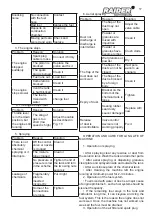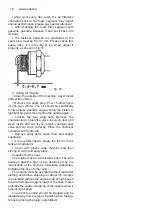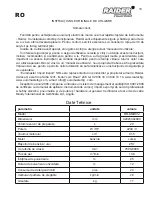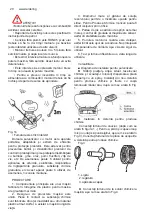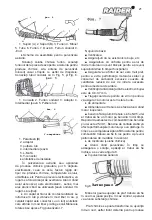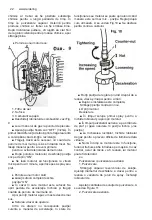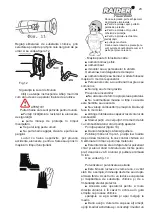
13
Versatility
■ Diagram of installation for spraying
► Loosen the wing nuts located in the chemical
tank and remove it. Replace roof dispersal plate
with one spray. Install chemical tank again and
turn nuts, as shown in Fig. 1.
► Installation in the chemical tank.
Connect the rubber hose (as shown in Figure
1..) To the plate and the small nozzle cap (do not
forget to put the seal, as shown in Fig.3). Connect
hose from the cover plate to the chemical tank.
Фиг. 3
1. seal
2. liaison
3. pressing cap
► Connect the hose to the chemical solution
to the machine, as shown in Fig.4
фиг. 4
1. Bracket (A) 2. Bracket (B) 3. Hose 4. Handle
5. Tube 6. Hose 7. Nozzle 8. Corrugated hose 9.
nozzle
♦ Scheme of assembly for aerial spraying.
Remove the hose chemical solution, remove
hose from the cover plate to the chemical
tank, strainer, dish sprayed. Replace the dish
sprayed with such dispersal. Connect the
corrugated tube as shown in Fig. 5 and Fig. 6.
фиг. 5
1.Bracket 2.Corrugated hose 3.Adapter
4.Intermediate pipe 5.Powder tube
Фиг. 6
У
-
накрайник
1. Bracket (B)
2. adapter
3. Powder tube
4. intermediate pipe
5. L-plug
6. Y-connector
♦ Installation Antistatic
In aerial spraying or application of granular
chemicals can be obtained electrostatic, which
is. related factors: the type of chemicals,
air temperature, humidity, etc. To prevent
electrostatic, please use the warning chain. When
the air is dry, electrostatic is - seriously, especially
when using corrugated pipe. Please note.
♦ One end of the antistatic contact wire is
inserted into the tube and vibrate freely in it, and
the other end is connected with an antistatic chain
that hangs freely and touches the ground. The
total grips to bend the sprayer Fig. 7.
както е показано на
Getting Started
■ Check
■ Check that there is no spark plug, etc.
■ Make sure the holes for the engine cooling
air are not blocked to prevent overheating during
operation.
■ Make sure the air filter is dusty, to avoid
poor engine performance and excessive fuel
consumption caused by the reduced amount of
entering air needed for combustion mixture.

















